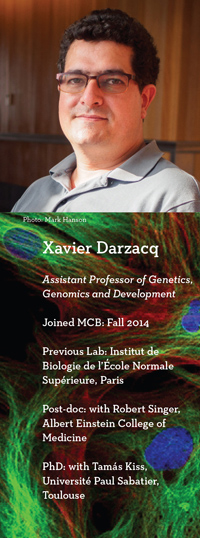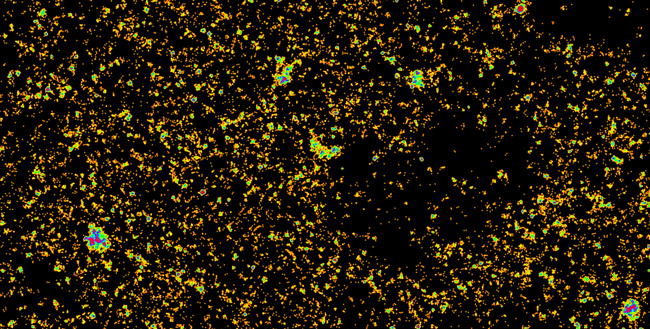MCB TRANSCRIPT

Gene Regulation and Differentiation: Tracking Nuclear Proteins in Live Cells
Once gene-regulating proteins are produced, the next step is reaching their target DNA. But we aren’t sure how that happens. Do the proteins diffuse randomly through the nucleus, or are they guided? To find out, MCB Assistant Professor Xavier Darzacq tracks individual proteins as they navigate the nucleoplasm in living cells.

“The nucleus is very crowded with DNA and other molecules so there’s only a small space to move in — we study the available space,” says Darzacq. To follow a single fluorescently-labeled protein amidst the visual noise of a cell, he borrowed an imaging technique astronomers use to see stars: a deformable mirror that corrects for aberrations, refocusing stray photons and so boosting the signal.
Computer analyses of and simulations based on the resulting trajectories suggest that gene-regulating proteins are guided. “We see proteins moving in a non-random manner,” Darzacq says, likening their routes to twisty European streets. “They move through a very complex mesh that’s like a network or a maze, it’s not a straight path.” Likely candidates for the “streets” that direct the proteins include DNA, which proteins can slide on.
Darzacq particularly wants to know how gene-regulating proteins are steered to particular stretches of DNA when cells differentiate. “During differentiation, the available space for diffusion can change, which changes the probability that molecules will interact with each other,” he says.
With an award from the California Institute for Regenerative Medicine, Darzacq brought his lab from France to UC Berkeley to apply his protein-tracking technique to healing in human skin. Wound healing entails differentiation of fibroblasts into muscle-like cells called myofibroblasts, which contract to help rejoin injured skin. But this process is sometimes impaired — the fibroblasts don’t differentiate into myofibroblasts — leading to chronic wounds that fail to heal.
“We don’t understand why,” Darzacq says, adding that a scratch can eventually lead to amputation of a foot due to defective myofibroblast differentiation. Besides helping people with chronic wounds, his work could give insights into regeneration of other tissue types as well as to how the fates of cells are decided in general.
Darzacq is happy to be part of MCB. “California is the best place on the planet for studying how a cell decides what kind to be,” he says. “And UC Berkeley has a fantastic critical mass of labs working on gene expression and differentiation.”





